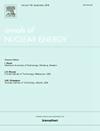基于引脚分辨中子和逐引脚子通道耦合的压水堆燃料组件弯曲仿真
IF 1.9
3区 工程技术
Q1 NUCLEAR SCIENCE & TECHNOLOGY
引用次数: 0
摘要
近年来,一些核反应堆经历了功率倾斜。根据核电站运行技术规范,反应堆只能在低于100%的功率水平下运行,严重影响了核电站的经济效益。针对燃料组件弯曲导致功率倾斜的问题进行了研究,提出了考虑高保真中子-热液耦合中燃料组件弯曲的仿真方法。在中子力学计算中,采用等效密度法模拟燃料组件弯曲。通过改变冷却通道的流动面积,考虑了燃料组件弯曲对热液反馈的影响。进行了一些试验来验证所提出方法的结果。结果表明,所提出的仿真方法可用于研究和分析先进压水堆燃料组件弯曲引起的功率倾斜。本文章由计算机程序翻译,如有差异,请以英文原文为准。
Simulation of the fuel-assembly bowing in PWR based on the coupling of pin-resolved neutronics and pin-by-pin subchannel
In recent years, some nuclear power reactors have experienced power tilts. According to the technical specifications for the operation of the nuclear power plant (NPP), the reactor can only be operated at a power level below 100%, which seriously affects the economic efficiency of NPPs. The bowing of fuel assemblies, which can lead to a power tilt, is investigated in this study, and the simulation method that considers fuel-assembly bowing in high-fidelity neutronics and thermohydraulic coupling is conducted. For the neutronics calculations, the equivalent density method is proposed to simulate the fuel-assembly bowing. The effect of the fuel-assembly bowing on the thermohydraulic feedback was taken into account by changing the flow area of the cooling channels. Some tests were performed to verify the results of the proposed method. The results show that the proposed simulation method can be used to study and analyze the power tilts caused by the fuel-assembly bowing in advanced PWRs.
求助全文
通过发布文献求助,成功后即可免费获取论文全文。
去求助
来源期刊

Annals of Nuclear Energy
工程技术-核科学技术
CiteScore
4.30
自引率
21.10%
发文量
632
审稿时长
7.3 months
期刊介绍:
Annals of Nuclear Energy provides an international medium for the communication of original research, ideas and developments in all areas of the field of nuclear energy science and technology. Its scope embraces nuclear fuel reserves, fuel cycles and cost, materials, processing, system and component technology (fission only), design and optimization, direct conversion of nuclear energy sources, environmental control, reactor physics, heat transfer and fluid dynamics, structural analysis, fuel management, future developments, nuclear fuel and safety, nuclear aerosol, neutron physics, computer technology (both software and hardware), risk assessment, radioactive waste disposal and reactor thermal hydraulics. Papers submitted to Annals need to demonstrate a clear link to nuclear power generation/nuclear engineering. Papers which deal with pure nuclear physics, pure health physics, imaging, or attenuation and shielding properties of concretes and various geological materials are not within the scope of the journal. Also, papers that deal with policy or economics are not within the scope of the journal.
 求助内容:
求助内容: 应助结果提醒方式:
应助结果提醒方式:


